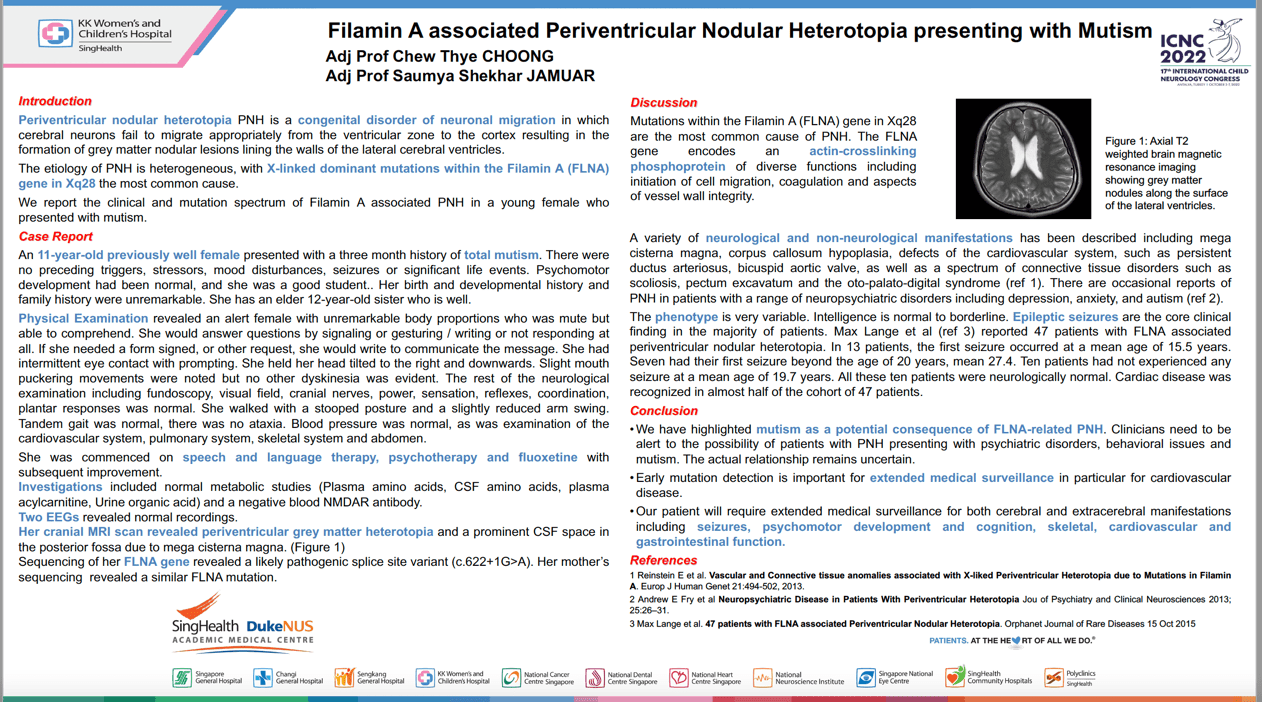Filamin A associated periventricular nodular heterotopia presenting with mutism
Chew thye Choong, Saumya Shekhar Jamuar
Introduction. Periventricular nodular heterotopia PNH is a congenital disorder of neuronal migration characterized by nodules of ectopic neurons situated adjacent to the lateral cerebral ventricular walls. Etiology and phenotype are heterogeneous. Mutations within the Filamin A (FLNA) gene (Xq28) are commonest cause. A variety of neurological and non-neurological manifestations have been described with epileptic seizures the predominant clinical finding. We report the clinical and mutation spectrum of PNH in a young female who presented with mutism. Case. An 11-year-old previously well female presented with a three-month history of total mutism. There were no preceding triggers, stressors, deterioration in school performance, mood disturbance, or seizure. There was no significant family history. She has an elder 12-year-old sister who is well. Examination revealed an alert female who was mute but able to interact via gestures and written communication. The neurological examination was normal. Blood pressure was normal, as was examination of the cardiovascular system, pulmonary system, skeletal system and abdomen. Investigations included normal metabolic studies (Plasma amino acids, CSF amino acids, plasma acylcarnitine, Urine organic acid ) and a negative blood NMDAR antibody . Two electroencephalograms revealed normal awake and sleep recordings. Her cranial MRI scan revealed bilateral periventricular grey matter heterotopia and a prominent CSF space in the posterior fossa due to mega cisterna magna. Sequencing of her FLNA gene revealed a mutation c622+1G>A (Splice Donor). Speech and language therapy, psychotherapy and fluoxetine led to minimal improvement. Conclusion. This report highlights a potential association between mutism and FLNA-related PNH.
Keywords: Periventricular nodular heterotopia , mutism , Filamin A
Chew thye Choong
KK Women’s and Children’s Hospital Singapore
Singapore
Saumya Shekhar Jamuar
KK women’s and Children’s Hospital
Singapore
Introduction. Periventricular nodular heterotopia PNH is a congenital disorder of neuronal migration characterized by nodules of ectopic neurons situated adjacent to the lateral cerebral ventricular walls. Etiology and phenotype are heterogeneous. Mutations within the Filamin A (FLNA) gene (Xq28) are commonest cause. A variety of neurological and non-neurological manifestations have been described with epileptic seizures the predominant clinical finding. We report the clinical and mutation spectrum of PNH in a young female who presented with mutism. Case. An 11-year-old previously well female presented with a three-month history of total mutism. There were no preceding triggers, stressors, deterioration in school performance, mood disturbance, or seizure. There was no significant family history. She has an elder 12-year-old sister who is well. Examination revealed an alert female who was mute but able to interact via gestures and written communication. The neurological examination was normal. Blood pressure was normal, as was examination of the cardiovascular system, pulmonary system, skeletal system and abdomen. Investigations included normal metabolic studies (Plasma amino acids, CSF amino acids, plasma acylcarnitine, Urine organic acid ) and a negative blood NMDAR antibody . Two electroencephalograms revealed normal awake and sleep recordings. Her cranial MRI scan revealed bilateral periventricular grey matter heterotopia and a prominent CSF space in the posterior fossa due to mega cisterna magna. Sequencing of her FLNA gene revealed a mutation c622+1G>A (Splice Donor). Speech and language therapy, psychotherapy and fluoxetine led to minimal improvement. Conclusion. This report highlights a potential association between mutism and FLNA-related PNH.
Keywords: Periventricular nodular heterotopia , mutism , Filamin A
Chew thye Choong
KK Women’s and Children’s Hospital Singapore
Singapore
Saumya Shekhar Jamuar
KK women’s and Children’s Hospital
Singapore

Chew thye Choong
KK Women’s and Children’s Hospital Singapore
KK Women’s and Children’s Hospital Singapore